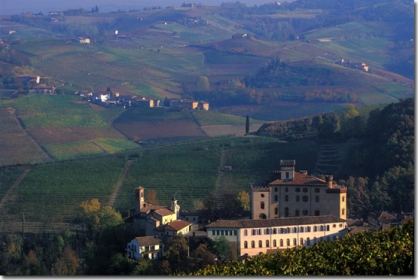
 Among the Barolo and Barbaresco hills
Among the Barolo and Barbaresco hills

filled by Giulia

A carousel of hills that intersect and overlooking a wide valley that is home to the capital of this land in Alba.
Eleven towns that host the Langhe "sanctuaries" winemaking of Barolo, Serralunga, Castiglione Falletto, La Morra, Novello, Monforte d'Alba, Grinzane Cavour, Diano D'Alba, Roddi Verduno, Dawn. A panorama of steeples, towers, castles, farms, large and rounded hills. And of course the vineyards, 1200 hectares in area, to be precise.
The Barolo production on these lands is an activity started from the early decades of the 800: a date between the two ways of understanding the wine making and wine. From Nebbiolo grapes in the area, in fact, for centuries, was obtained a lovely wine characteristic for its high sugar content. It was the Marchesa di Barolo, Julia Falletti who created the production of Nebbiolo as a dry wine, making it "trendy wines of Bordeaux." "The advice received by Count Odart, the famous French winemaker in the area called by the then young Camillo Benso Count of Cavour to revive the fortunes of their cellars, brought convincing and exciting results. The wine was named after the residence of the Marquise. Thus was born the Barolo.
Barolo is not like other villages on top of a hill, but half of the valley, on a sort of promontory which collects the houses and the castle of the Marquis Falletti. The square in front of the castle is the parish church of San Donato, where there is the tomb of the ancient feudal lords. This is the home of the Enoteca Regionale del Barolo. In addition to the exhibition of the bottles of member producers, the Enoteca is possible to taste and buy the bottles you want.
How it is possible to male it in the cellars of the other ten villages around.
To the north east of Alba is a small ravine Lana that includes the towns of Barbaresco, Treiso, Neive and S. Rocco Seno d'Elvio. Here the hills are sweet and opens as a huge amphitheaters, where the Tanaro divides them from the plain.
A little more than two million bottles of Barbaresco are produced here on a surface of about five hundred acres of vineyards lying between the 400/500 meters above sea level. Old country houses, farms in the countryside, small churches and chapels ...
Barbaresco is not a wine of any kind and many, especially abroad, even regard him as the best of Italian wines.
Despite the homogeneity of the territory, each vineyard is different from a thousand different shades, small nuances of fragrance: purple tobacco, licorice ... in Treis, looking at the vineyards to the highest ridges of the hills can admire the Rocca called "dei sette fratelli":
a series of gullies overlook and whose origin is lost in the natural causes that attribute the phenomenon of water erosion and the dramatic events of the mysterious tales of the past.
Neive is located on the top of a crown. Its historic center is very well preserved and are found several historical and architectural evidence of the past of the town. All the medieval center is worthy of attention, with beautiful stone houses, the restored wooden doors, the street with its ups and downs that opens onto manicured gardens.The hills of Barbaresco is overlooked by numerous small businesses and farms.
In addition to tastings in the cellars of the area, gourmets we recommend a stop at one of the many restaurants offering local cuisine provided menu.
|
|
 |






















